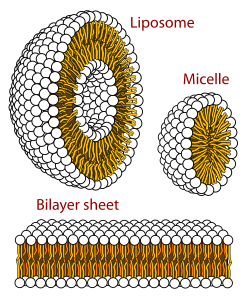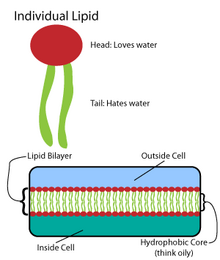Amphiphile


Anamphiphile(from the Greek αμφις amphis, both, and φιλíαphilia,love, friendship), oramphipath,is achemical compoundpossessing bothhydrophilic(water-loving,polar) andlipophilic(fat-loving) properties.[1]Such a compound is called amphiphilic or amphipathic. Amphiphilic compounds includesurfactantsanddetergents.Thephospholipidamphiphiles are the major structural component ofcell membranes.
Amphiphiles are the basis for a number of areas of research in chemistry and biochemistry, notably that oflipid polymorphism.
Organic compounds containing hydrophilic groups at both ends of the molecule are calledbolaamphiphilic.Themicellesthey form in the aggregate areprolate.
Structure
[edit]Thelipophilicgroup is typically a largehydrocarbonmoiety,such as a long chain of the form CH3(CH2)n,with n > 4.
Thehydrophilicgroup falls into one of the following categories:[citation needed]
- charged groups
- anionic.Examples, with the lipophilic part of the molecule represented byR,are:
- carboxylates:RCO2−
- sulfates:RSO4−
- sulfonates:RSO3−
- phosphates(the chargedfunctional groupinphospholipids)
- cationic.Examples:
- ammoniums:RNH3+
- anionic.Examples, with the lipophilic part of the molecule represented byR,are:
- polar, uncharged groups. Examples arealcoholswith large R groups, such as diacyl glycerol (DAG), andoligo ethylene glycolwith long alkyl chains.
Often, amphiphilic species have several lipophilic parts, several hydrophilic parts, or several of both.Proteinsand some blockcopolymersare such examples.[citation needed]
Amphiphilic compounds have lipophilic (typicallyhydrocarbon) structures and hydrophilic polar functional groups (either ionic or uncharged).[citation needed]
As a result of having both lipophilic and hydrophilic portions, some amphiphilic compounds may dissolve in water and to some extent innon-polarorganic solvents.
When placed in an immiscible biphasic system consisting of aqueous and organic solvents, the amphiphilic compound will partition the two phases. The extent of the hydrophobic and hydrophilic portions determines the extent of partitioning.[citation needed]
Biological role
[edit]
Phospholipids,a class of amphiphilic molecules, are the main components ofbiological membranes.The amphiphilic nature of these molecules defines the way in which they form membranes. They arrange themselves intolipid bilayers,by forming a sheet composed of two layers of lipids. Each layer forms by positioning their lypophilic chains to the same side of the layer. The two layers then stack such that their lyphphilic chains touch on the inside and their polar groups are outside facing the surrounding aqueous media. Thus the inside of the bilayer sheet is a non-polar region sandwiched between the two polar sheets.[2]
Althoughphospholipidsare the principal constituents of biological membranes,[3]there are other constituents, such ascholesterolandglycolipids,which are also included in these structures and give them different physical and biological properties.[citation needed]
Many other amphiphilic compounds, such aspepducins,strongly interact with biological membranes by insertion of the hydrophobic part into the lipid membrane, while exposing the hydrophilic part to the aqueous medium, altering their physical behavior and sometimes disrupting them.[citation needed]
Aβ proteins form antiparallel β sheets which are strongly amphiphilic,[4]and which aggregate to form toxic oxidative Aβ fibrils. Aβ fibrils themselves are composed of amphiphilic 13-mer modular β sandwiches separated by reverse turns. Hydropathic waves optimize the description of the small (40,42 aa) plaque-forming (aggregative) Aβ fragments.[5]
Antimicrobial peptides(AMPs) are another class of amphiphilic molecules, abig dataanalysis showed that amphipathicity best distinguished between AMPs with and without anti-gram-negative bacteria activities. The higher amphipathicity, the better chances for AMPs possessing antibacterial and antifungal dual activities.[6]
Examples
[edit]There are several examples of molecules that present amphiphilic properties:
Hydrocarbon-basedsurfactantsare an example group of amphiphilic compounds. Their polar region can be eitherionic,or non-ionic. Some typical members of this group are:sodium dodecyl sulfate(anionic),benzalkonium chloride(cationic),cocamidopropyl betaine(zwitterionic), and1-octanol(long-chain alcohol, non-ionic).[citation needed]
Many biological compounds are amphiphilic:phospholipids,cholesterol,glycolipids,fatty acids,bile acids,saponins,local anaesthetics, etc.[citation needed]
Soapis a common household amphiphilic surfactant compound. Soap mixed with water (polar, hydrophilic) is useful for cleaning oils and fats (non-polar, lipiphillic) from kitchenware, dishes, skin, clothing, etc.
See also
[edit]- Amphoterism
- Bubbles in abiogenesis
- Emulsion
- Freesurface energy
- Surfactant
- Lipid polymorphism
- Sodium dodecyl sulfate
- Wetting
- Viral envelope
References
[edit]- ^Betts, J. Gordon. "3.1 The cell membrane".Anatomy & physiology.OpenStax.ISBN978-1-947172-04-3.Retrieved14 May2023.
- ^"Amphipathic".Biology-Online Dictionary.Retrieved2016-11-17.
- ^"Structure of a Membrane".The Lipid Chronicles.5 November 2011.Retrieved2020-06-02.
- ^Schubert, D; Behl, C; Lesley, R; Brack, A; Dargusch, R; Sagara, Y; Kimura, H (14 March 1995)."Amyloid peptides are toxic via a common oxidative mechanism".Proceedings of the National Academy of Sciences of the United States of America.92(6): 1989–93.Bibcode:1995PNAS...92.1989S.doi:10.1073/pnas.92.6.1989.PMC42408.PMID7892213.
- ^Phillips, J.C. (20 May 2015). "Thermodynamic description of Beta amyloid formation using physicochemical scales and fractal bioinformatic scales".ACS Chemical Neuroscience.6(5): 745–50.doi:10.1021/cn5001793.PMID25702750.
- ^Chien-Kuo Wang; Ling-Yi Shih; Kuan Y. Chang (2017-11-22)."Large-scale analysis of antimicrobial activities in relation to amphipathicity and charge reveals novel characterization of antimicrobial peptides".Molecules.22(11): 2037.doi:10.3390/molecules22112037.PMC6150348.PMID29165350.
